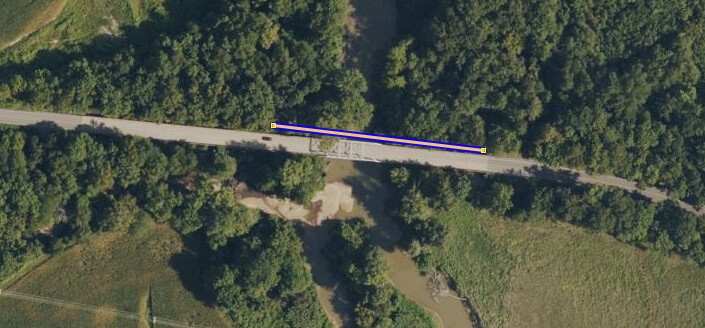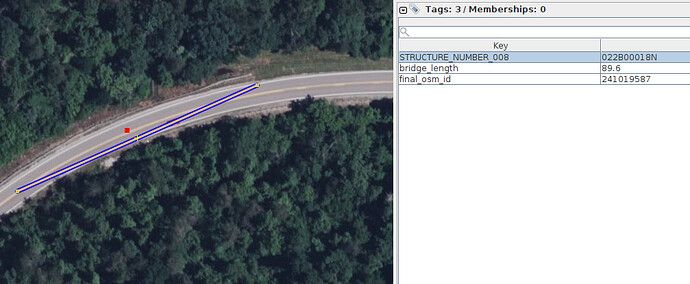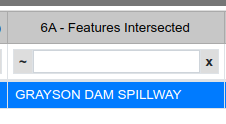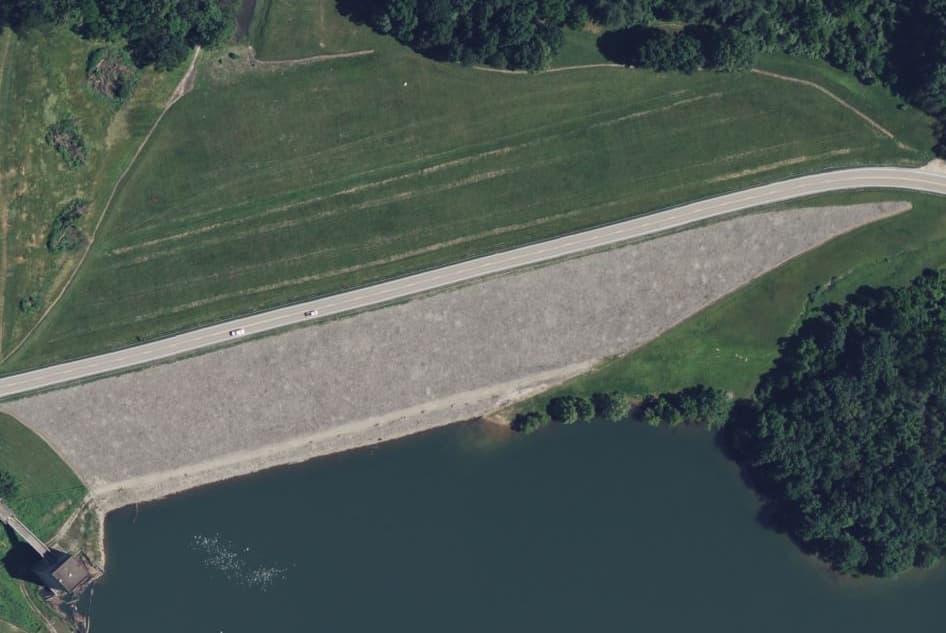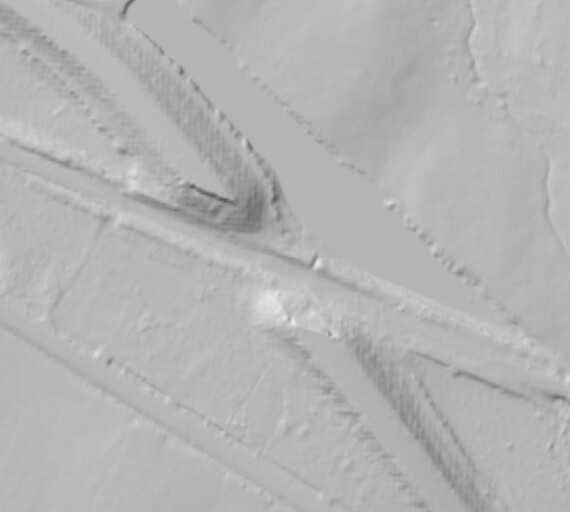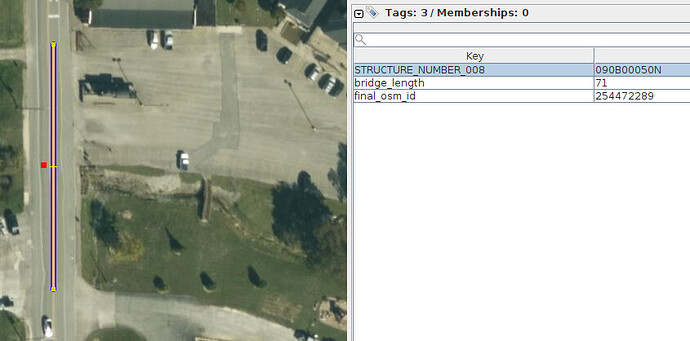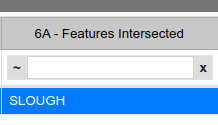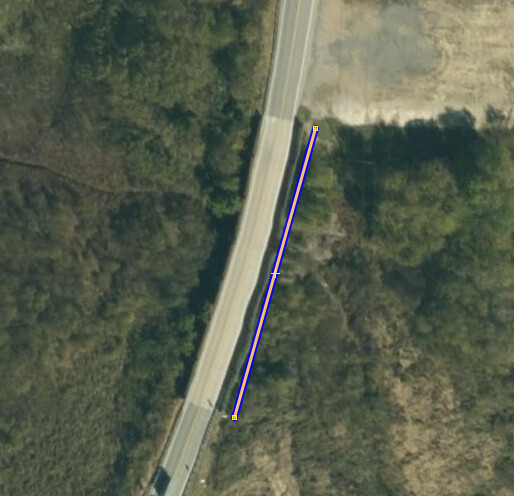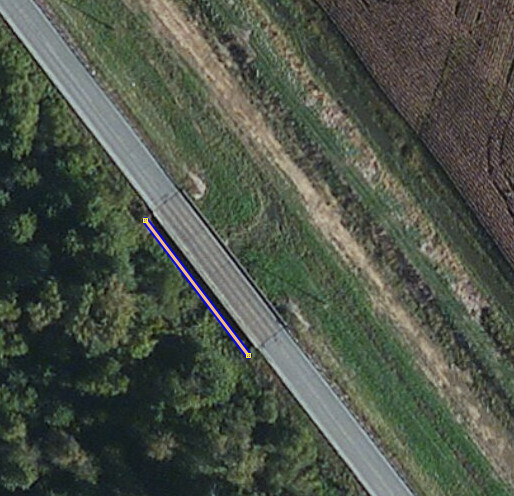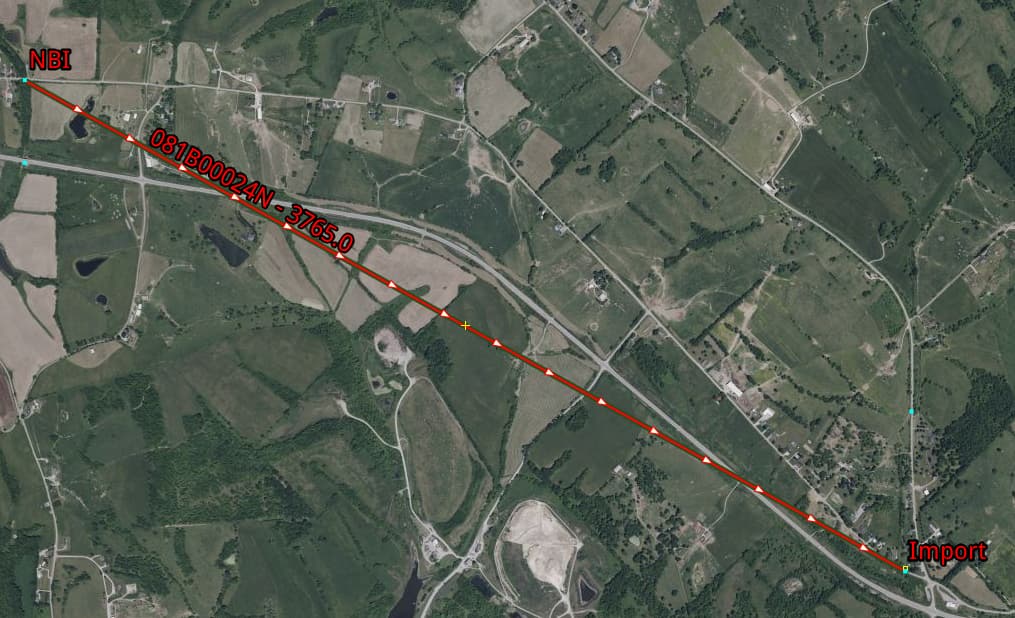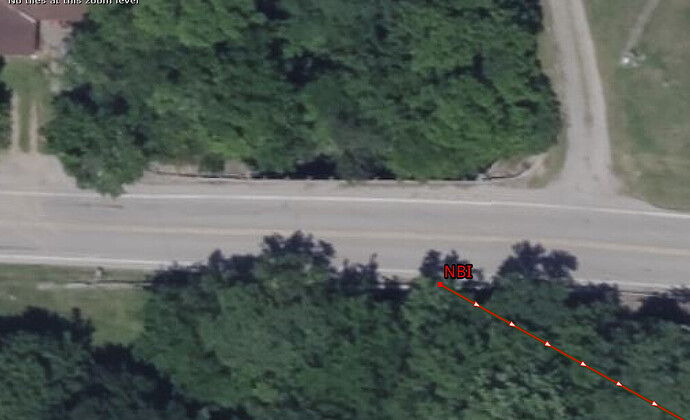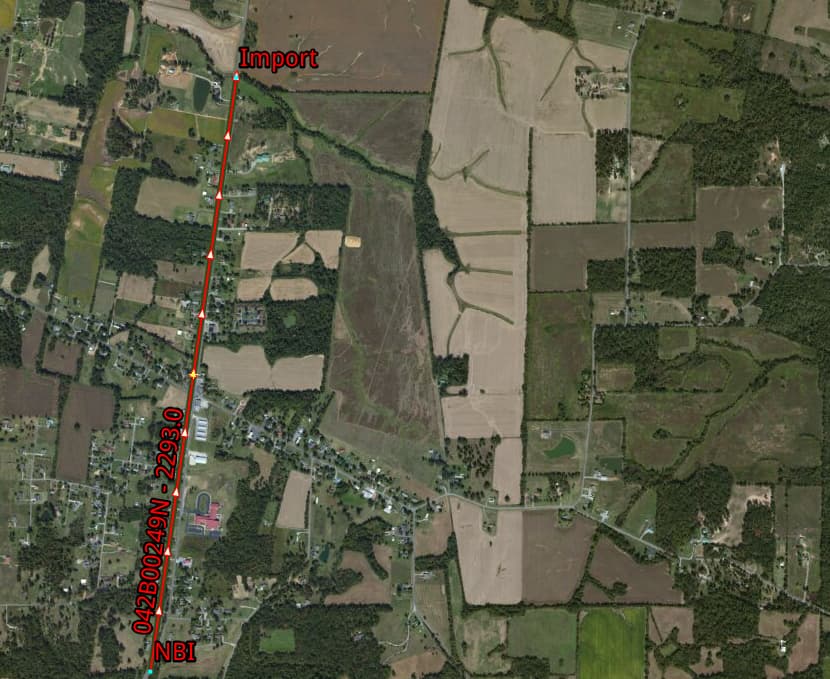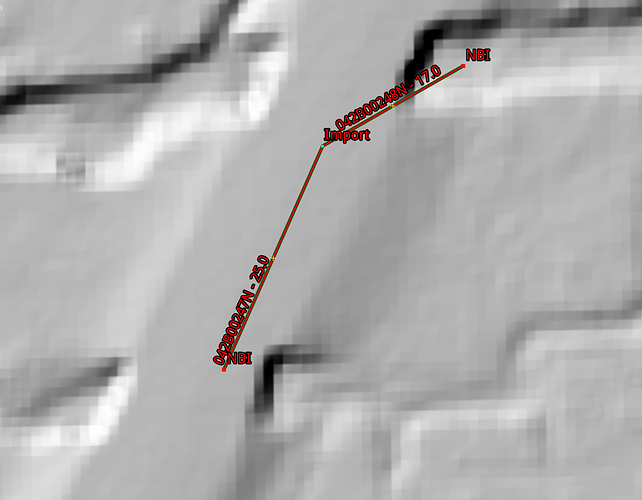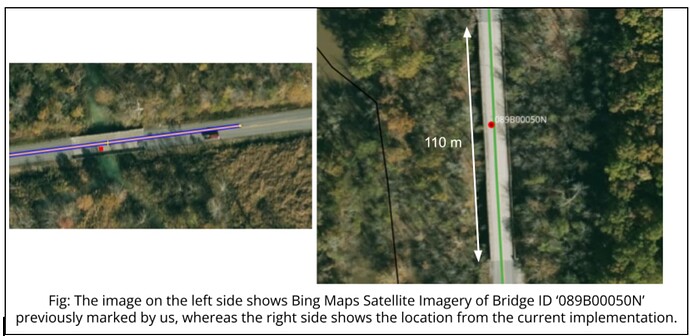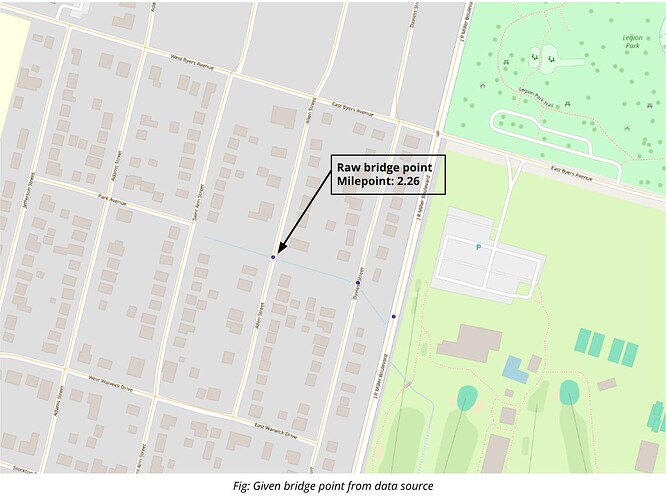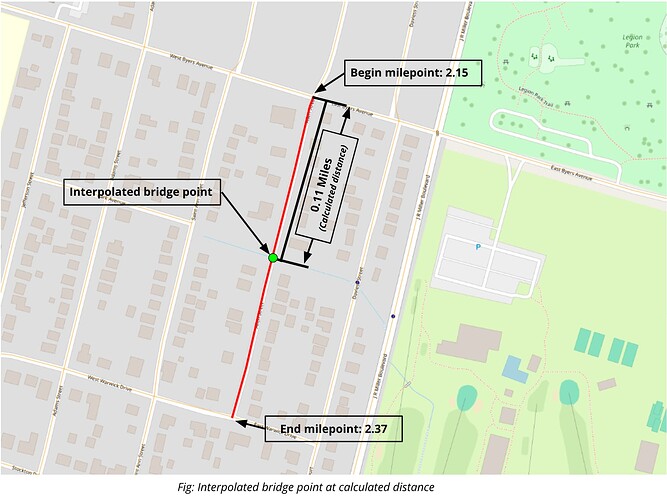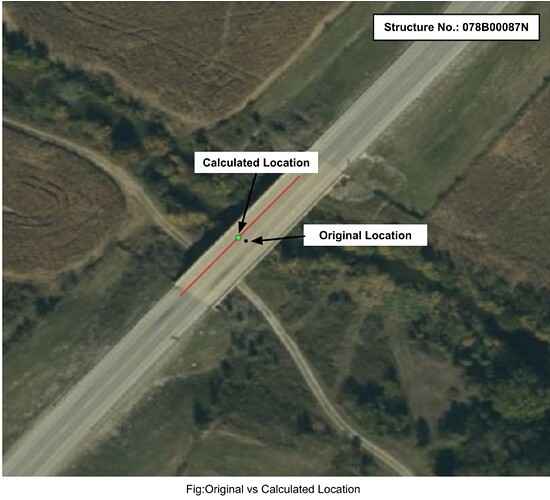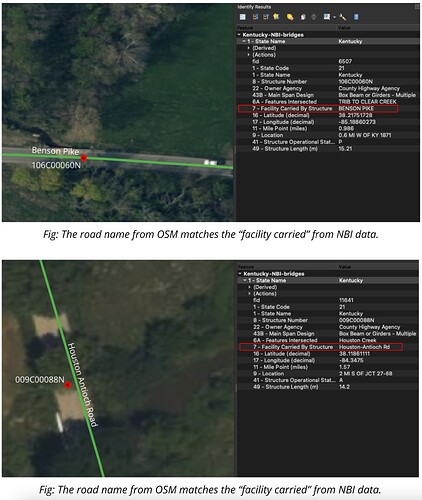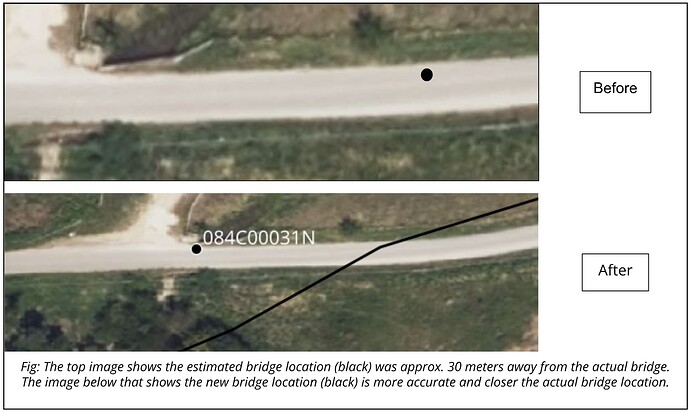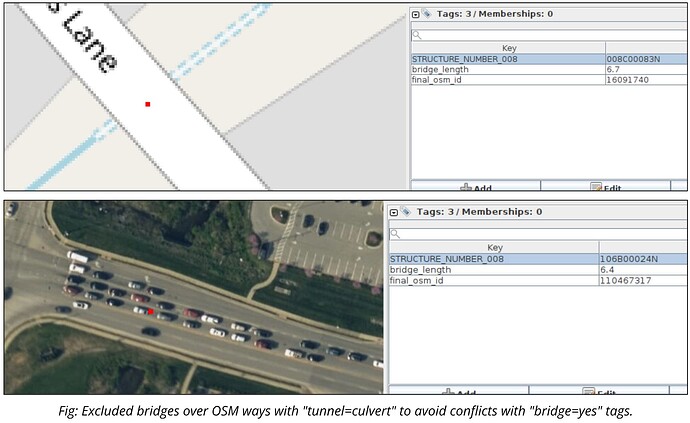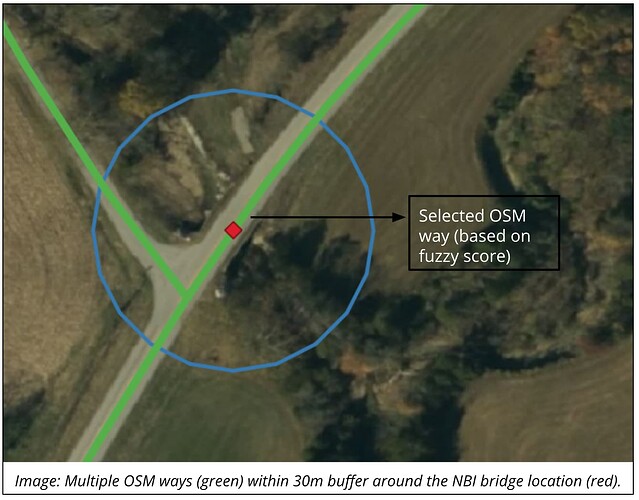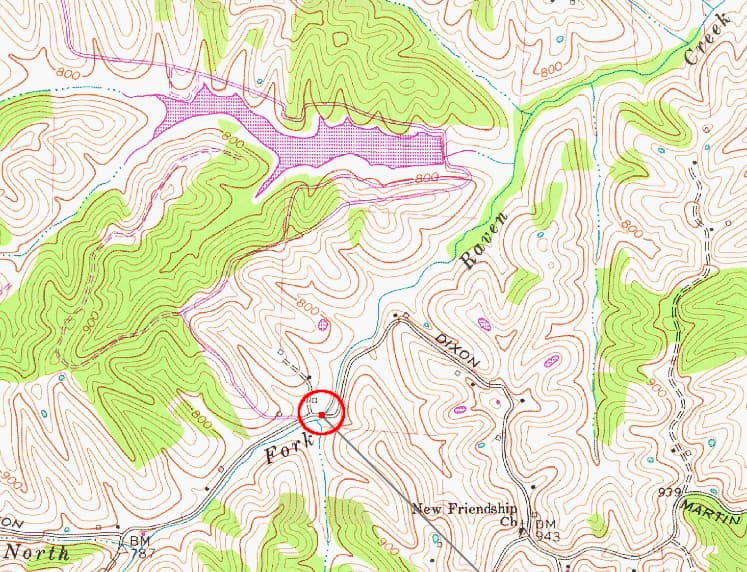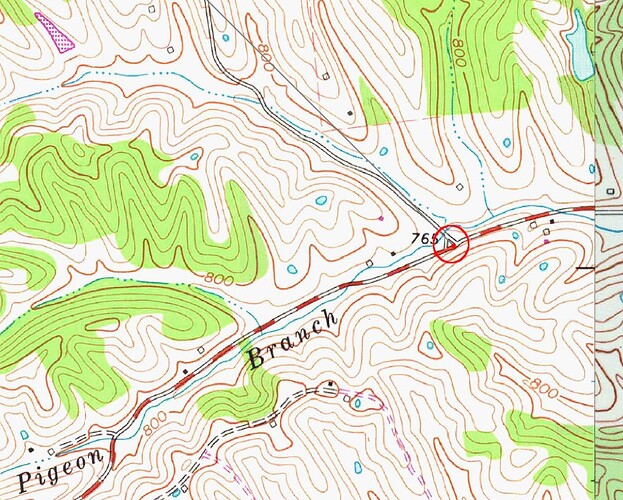As opposed to continuing to look at individual cases, I started to look for bigger patterns in the proposed import.
The first observation is that there are many cases where the data preparation process has moved the NBI location a significant distance. For example, in 102 cases the import preparation process moved the NBI location by more than 500 meters, and in 29 cases it moved it by more than 2,000 meters!
38.5854685, -83.6997145 (import location)
38.601944, -83.7375 (NBI location)
STRUCTURE_NUMBER_008=081B00024N
In the above case, the import preparation process moved the NBI location by over 3,700 meters!
In the above screenshot, one can clearly see a bridge at the NBI location.
36.9312123, -88.5182525 (import)
36.91083, -88.52194 (NBI)
STRUCTURE_NUMBER_008=042B00249N
In the above case the import preparation process moved the NBI location 2,293 meters.
As shown above in the Bing aerial imagery, at the NBI location there is clearly a bridge.
36.9102061, -88.5223863
STRUCTURE_NUMBER_008=042B00247N
STRUCTURE_NUMBER_008=042B00248N
Even moving the NBI locations a short distance can cause problems. In the case pictured above, the import preparation process moved one bridge 17 meters and the other 25 meters to occupy the same location, when in reality, there are two separate bridges here as shown by the 3DEP hillshade.
The Esri World Imagery (Clarity) Beta shown above also shows two bridges here.
The second observation is that there are 71 locations in the proposed import where two or more bridges share the exact same location - probably as a result of the import preparation process moving bridge locations as illustrated earlier:
Latitude Longitude Structure Numbers
36.719673424004, -89.038317151181: 053B00039N, 053B00041N
37.489934268573, -87.495942596539: 117B00018N, 117B00017N
37.117242693894, -87.003885952907: 089B00016N, 089B00017N
36.897110145777, -86.580231876884: 114C00027N, 114C00034N
36.708704430084, -88.690148836385: 042B00093N, 042C00212N
36.884785947056, -88.550484108321: 042B00224N, 042B00223N
38.217520041029, -85.188622958580: 106C00060N, 106C00070N
37.545446678329, -82.199250609809: 098B00180N, 098B00195N
38.064938458925, -83.848522039311: 087B00037N, 087B00058N
38.397971860108, -84.649695276197: 105B00140N, 105B00134N
37.637375021148, -86.594565038168: 014C00045N, 014C00053N
37.522970144052, -84.637339562357: 069C00108N, 069C00062N
37.582181390558, -86.756692708028: 092B00021N, 092B00020N
37.624318452150, -88.130280121859: 113B00088N, 113B00084N
36.742423000000, -88.281900619737: 018B00113N, 018B00114N
37.133489547966, -83.440230090560: 066C00071N, 066C00029N
37.223088950481, -87.353745057594: 054B00050N, 054B00051N
38.585468460958, -83.699714491691: 081B00054N, 081B00024N
37.290011759755, -82.471367926402: 098C00156N, 098C00175N
37.351410272539, -87.465548380698: 054B00223N, 054B00027N
37.822437058773, -87.794825105446: 051B00040N, 051B00041N
36.597051291298, -88.871663944170: 053B00108N, 053B00109N
37.274663833216, -87.143255214437: 089C00038N, 089C00039N
37.592242697759, -84.499461961902: 040C00053N, 040C00054N
37.437899808535, -86.929116074300: 092B00146N, 092B00144N, 092B00145N
37.722192058596, -86.993474976373: 030B00128N, 030B00127N, 030B00129N
37.463407068981, -86.660764490683: 092B00037N, 092B00036N
37.820018167222, -82.888733548501: 058B00079N, 058C00016N
37.293318752678, -88.447274213415: 070B00056N, 070B00057N, 070B00055N
38.341319406124, -84.660999218820: 105C00065N, 105C00064N
37.048336229059, -84.773427356314: 100C00075N, 100C00079N
36.781739050665, -88.529110966495: 042B00038N, 042B00039N
36.725665443193, -88.232144284468: 018B00067N, 018B00066N
37.575924102746, -85.740234943490: 062B00034R, 062B00038L
38.282484767604, -84.338040330519: 009C00066N, 009C00065N
36.864932005621, -85.847457004015: 005C00050N, 005B00017N
36.910206124189, -88.522386336237: 042B00248N, 042B00247N
37.645265593433, -87.010772760179: 030B00034N, 030B00032N, 030B00033N
37.211421423005, -83.047723668701: 097B00090N, 097C00070N
37.822802009976, -85.223064650848: 115C00030N, 115C00050N
37.811685952382, -85.047663686514: 115C00049N, 115C00079N
38.205655984159, -83.772049008656: 006B00090N, 006B00079N
37.757484654868, -85.130204603737: 115B00064N, 115B00053N
38.529149623464, -83.348219150978: 068C00063N, 068C00095N
36.733160115499, -88.150970971632: 018B00118N, 018B00119N
36.971832294713, -87.641032879677: 024C00200N, 024C00199N
37.273997264650, -82.867729512408: 060C00028N, 060B00031N
37.156088067383, -87.097296688527: 089B00116N, 089B00104N
37.677297290858, -85.891319142599: 047B00144R, 047B00144L
38.528135226454, -83.908715094360: 081C00060N, 081B00016N
37.463222462160, -86.916929262422: 092B00163N, 092B00178N, 092B00182N
37.289633579008, -87.672898704820: 054B00127N, 054B00128N, 054B00126N
37.867407828103, -87.810518980426: 051B00044N, 051B00045N
38.490963058294, -83.039803968521: 045C00076N, 045C00144N
36.862418145618, -88.572620696859: 042B00209N, 042B00210N, 042B00208N
38.101972330196, -84.181383294555: 009B00020N, 009B00021N
37.476920521727, -82.429421318952: 098B00157N, 098B00235N
37.062396893151, -88.797050607638: 073B00035N, 073B00036N
38.170541512282, -85.689587710971: 056C00076N, 056C00077N
37.724342411705, -87.610961771595: 051B00103N, 051B00102N
37.062543900115, -88.799498855587: 073B00037N, 073B00038N
37.302679944885, -87.323587550133: 089B00050N, 089B00049N
37.457587754759, -85.095110007007: 078C00112N, 078C00125N
38.174638765698, -83.515493875958: 103C00114N, 103C00101N
37.152627859635, -88.945213780696: 004B00033N, 004B00034N
36.865680122951, -83.192478874376: 048B00158N, 048C00131N
37.681282909487, -85.876897326563: 047B00143L, 047B00143R
37.702539744809, -87.066054679100: 030B00036N, 030B00037N
37.459626628999, -87.850550570797: 117B00038N, 117B00041N
37.265749812919, -82.654625933708: 098C00121N, 098B00189N
37.856829047498, -85.446693461061: 090C00047N, 090C00054N
The bottom line is that this import should not be done as currently proposed. Instead, the NBI should be loaded into Maproulette and each case should be handled individually - making sure that the features carried, features intersected, and the bridge length match the location.













